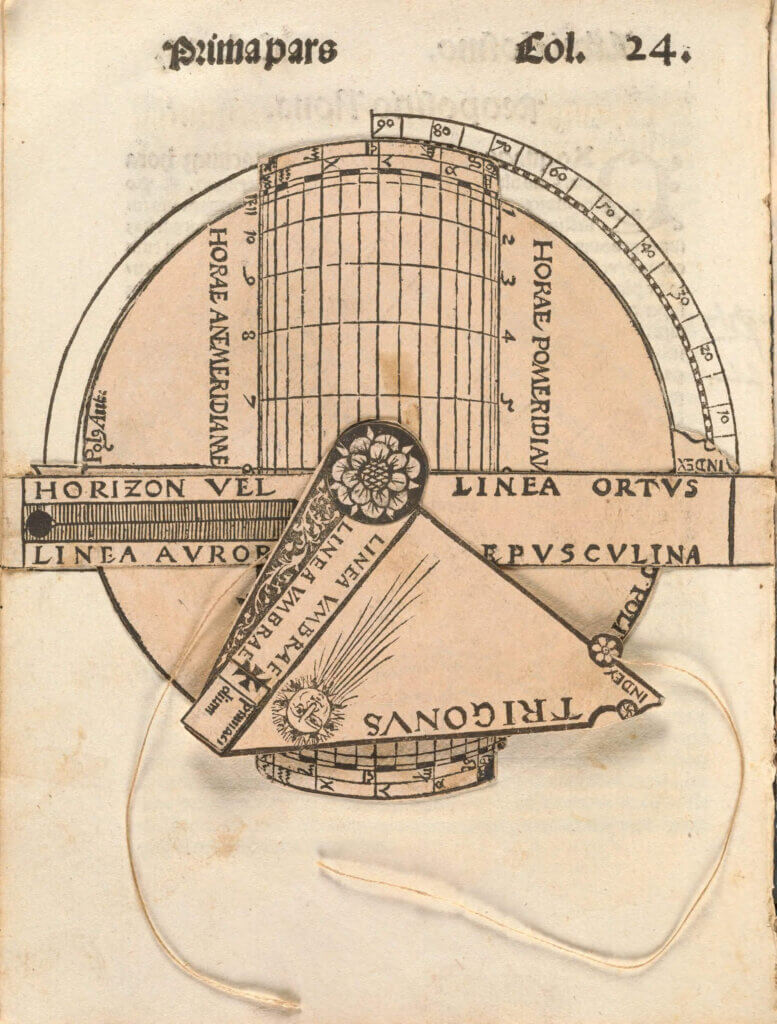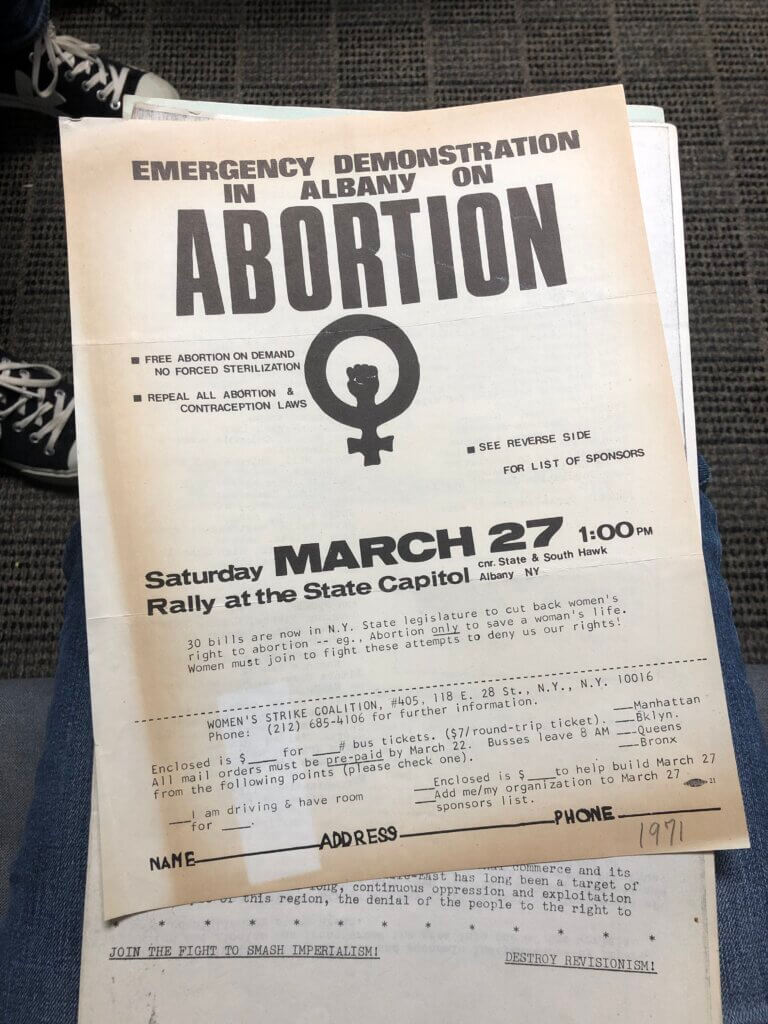What follows is a talk I gave (over zoom) on June 29, 2022, for the London Rare Book School. I’m deeply grateful to Elizabeth Savage for the invitation to speak—both for her original invitation to deliver this in person back in the summer of 2020 and for her invitation to revisit this as a zoom talk now. Back when we had first planned this, I was in the early public stages of talking about feminist bibliography; now, I think, I’m maybe a bit closer to a sense of what I’m up to in thinking about FemBib. Or, at least, I have a clearer sense that part of what I’m up to doesn’t involve answers, but focuses on questions and on the intersections between materiality/ideology, personal/political, academia/public scholarship, bibliography/not-bibliography, text/not-text. I’m sharing this talk because it most accurately reflects the place that I’m in right now, and I have not yet worked out what I’d like to do with this work. For now, I’m giving it to you this way, so that you can build from it. (Note: There are some differences between what I said and was recorded, and what I have written below—good luck with your version control, sorry/not sorry, but make sure you read the footnotes where I expand on what I said. If you’re really curious about the other states of this work, my cv links to other versions of this talk that have been recorded, and at some point soon my own ongoing reflections on what it all could mean will be shared here with the tag #FemBib.)
Update 9/11/2022: A pdf of this talk (with images and links) has been deposited in the Humanities Commons at https://doi.org/10.17613/sjs2-8z89.
I had thought I would start this talk with the usual story I tell about the origin of this FemBib project, the tale of why I got interested what feminist bibliography might be. But that was before the legal framework in which I exist as a United States citizen finally broke apart to reveal a new reality, one in which I, as someone with a uterus and ovaries, exist as a person only to the extent that I might have to give it away in order to become an incubator. My bodily autonomy—my personhood, my right to control what I do with my own body and my own life—isn’t mine after all, but only something that I hold in abeyance. And because I have almost always, by virtue of my reproductive system and my sexual activity, been in a state of maybe-or-maybe-not-pregnancy, I am now almost always in a state of maybe-or-maybe-not-personhood.
A quick aside about this maybe-maybe-not: the way fertilization and implantation and counting gestation works, most pregnancies aren’t registered as such, as a missed period or a chemical change, until at least four weeks of gestation. If you haven’t been pregnant, or haven’t been avoiding getting pregnant, you might not realize this. Gestational counting starts from the first day of your last period, not the date of ovulation. So the earliest you can know you’re pregnant—two weeks after you’ve ovulated and in theory the first day of your missed period—you are already 4 weeks on. I say this in part because it’s why the six-week limits that are now going into effect in some places are so insidious. Six weeks, a person might think. That’s plenty of time to miss a period and decide what to do! But no, six weeks is at most two weeks. Language and counting matters. For more than half the world population, every two weeks we rotate between definitely-not-pregnant and maybe-pregnant until the question is either resolved by pregnancy or multiple layers of birth control, and we deserve the right to take care of ourselves.
Anyway. Here I am, today, probably a person, because I am probably not pregnant, thanks to age and my IUD.
I’m also probably a woman because that’s pretty much how I feel about myself. But I also say “probably” because being a woman can be surprisingly complicated. There are behaviors you should or should not exhibit, personality traits that you should or should not have, and if you move from, say, one community to another, you might find that behaviors you had learned as being totally appropriate for women are, in this new group, completely inappropriate. Do you smile with your teeth showing or not? Do you make eye contact? Do you wear pants? Do you show your hair in public? Do you show the right amount of bare skin, or too much, or too little? None of that is straightforward and all of it is constantly monitored.
When I was in elementary school, I went to a friend’s birthday party, and we played one of those stupid games that you play at girls’ gatherings when they’re at the age of trying to figure out how to be. And at some point, the question asked to the group was, “How do you hold your hands when you’re looking at your nails?” The entire group flipped over their hands to look at the backs of their hands with their fingers extended. I curled my fingers in over my palms and looked at my nails that way. And that’s when I learned that I was not good at being a girl.
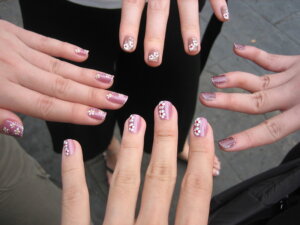
(November 2006); CC BY-NC

That’s origin story number 1 for this project.
Origin story number 2 is this: My PhD was on Shakespeare and feminist theater and it was called “Act Like a Feminist.” I had some throwaway line in my preface draft about how realizing I was a feminist made my life so much easier. One of my advisors—Barbara Hodgdon, a wonderful scholar and mentor and a fierce feminist—Barbara wrote in the margins of my draft something along the lines of, “What, are you sure? Being a feminist has made my life so much more difficult!” And it probably did, for her, and it definitely can for others—the activism and arguments and facing male sneers and anger. But for me, being able to take what I had always felt and to find a name and framework for it—what a relief! It wasn’t that I was bad at being a girl. I was good at being a girl the way I wanted to be, not the way they wanted me to be. Feminism gave me a way of understanding the world and my current and potential places in it, a way of arguing and resisting and making my own path.
I suspect, if you’re listening to this talk, that you, too, are someone who is aware of the longings people often have to make sense of things. If you’re a bibliographer, you might not also be a philosopher, but if you’re someone who is curious about how things work, you probably are also curious about why things work that way. Why is this book put together in this way? Why does this sheet exist in two different states? Why do we care about collational formulas for letterpress books but not for the intaglio plates in them? All of that is a longing for a methodology to go along with our methods, a wish not only to count the leaves in a book but to understand why it’s important to count some leaves and not others. A way of making sense that isn’t random but meaningful. A way of making sense that isn’t needlessly rigid but that allows for us—maybe even encourages us—to stop and wonder, But shouldn’t I also be counting these other leaves? What happens if I do?
My desire for a feminist bibliographical praxis is a desire to find a way to make sense of the work I do both as a scholar and as a person finding her way in the world, a desire to create a way of working that might help others also understand and expand our sense of the possibilities of what’s around us.
I’m going to pause here to state explicitly what my feminism is, since it’s become very apparent over the years that different people use this term in different ways. My feminism is inclusive of race, sex, gender, sexuality, ethnicity, religion, ability, and class; is always political; and is striving to improve the world. I want to emphasize one point in particular, since it is a hot point and it’s infuriating: sex is not gender, transwomen are women, and the attacks on women’s right to control their lives are the same attacks on trans people to control their lives.
What this means for my life is that I live through a feminist framework that strives to free everyone from the constraints that gender places on us, and that the scholarly work I do should reflect the values that shape how I engage with the world. What this means for my bibliography is that I think all textual artifacts should be part of a feminist praxis and that all people can be part of this work.
This is a good time to consider another set of definitions: What is bibliography? The simplest answer is that it’s the study of books and their material incarnations. W. W. Greg’s answer in 1945:
The object of bibliographical study is to reconstruct for each particular book the history of its life, to make it reveal in its most intimate detail the story of its birth and adventures as the material vehicle of the living word.1W. W. Greg, “Bibliography—A Retrospect,” in The Bibliographical Society 1892–1942: Studies in Retrospect (London: BIbliographical Society, 1945), 24.
And that’s often the way that I’ve taught book history, asking my students to culminate their research with a biography of their book’s life story. But it’s also a definition that is very focused on books. (And as a relevant aside, I don’t want to hear any more intimate details of birth stories; people who have given birth have shared enough intimate details of what happens to our bodies and no one should have to share those moments with anyone in order to be seen as valid.)
In 2020, for the Bibliographical Society of America, Thomas Tanselle wrote a lovely account of what bibliography does, complete with characteristics of different approaches, including analyzing physical clues, describing the material artifact, determining the relationships between books carrying the same works, and writing histories and technical studies of the materials and processes used in bookmaking, bookselling, and book collecting. His expansive definition ends with a more human-focused answer than earlier bibliographers might have provided:
What links all bibliographical pursuits is an understanding of the significance of books as tangible products of human endeavor.2G. Thomas Tanselle, “Bibliography Defined” (2020) https://bibsocamer.org/about-us/bibliography-defined/.
(And a quick aside here is that Tanselle uses “books” here in the way that I do: as the best handy term we have for textual objects, be they codices, scrolls, tablets, or digital.)
What I hope is clear from this is that bibliography provides the basis for all other kinds of textual work. You can’t really understand the connections between a work and its audience or the intentions of an author or even the words on the page if you don’t know which text an audience was reading or whether a published text derives from an author or whether those words on the page are always the same words in other copies and editions of that work. Not everyone has to be a bibliographer, but we need to draw on bibliographical work in order to do anything else.
My work as a bibliographer can be summed up as trying to inspire in others a desire to explore how textual artifacts can bring us closer to understanding how people and technologies and cultures work. That seems both overly broad and a tad ridiculous sometimes. Most bibliographers probably identify a specific field or research question as their framework. And I do have a field—the first centuries of the printing press. But my research question is more about pedagogy than identifying type or recreating the output of a printing house or naming early booksellers. All of those things are great questions to work on, but they are not mine. My burning question is,
How do I get you to want to do this? What can I do to make you see the possibilities and joys of this field? How can I help you want to make bibliography enticing and exciting to newcomers?
One output of that research question is my book. Studying Early Printed Books 1450–1800: A Practical Guide is for anyone who has to learn the basics of working with these objects, anyone who needs to understand how early printed books were made and why it matters that we know these things, anyone who needs to be able to find and access early printed books, anyone who needs to show up in a reading room feeling like they have the skills to be able to make sense of the books in front of them. I wrote the book I needed to teach with since that book didn’t exist and it was profoundly shaped by my experiences in the classroom. But it was also shaped by my own experiences of trying to learn basic bibliographical skills long after I’d left graduate school.
So here’s another origin story, back from when all things bibliographical were Greek to me: At some point after I’d become a regular reader at the Folger Shakespeare Library but before I started diving into book history, an out-of-town friend needed to fact check a quote, so she asked me if I could pull up the book, confirm the passage, and let her know where in the book it occurred. An easy enough request. But at that point I was not working with anything printed before 1910, and while I had some basic familiarity with old books from my graduate courses—well, one course, really, with Rebecca Bushnell—it had been a long time since I’d looked at any. Reading the text wasn’t a problem for me, but I could not remember what the deal was with signature marks. As in, I knew that I had to cite the page and that I could do that with those numbers printed at the bottom, but I did not know what to do with recto and verso. Was the page opposite B3 B3verso or B2verso? It’s such a basic skill!
But I did not have it at my fingertips and I was much too embarrassed to ask anyone for help—I didn’t yet know other readers, and I didn’t want to expose myself to the librarians as ignorant. There didn’t seem to be an obvious resource to figure this out, so I did what I always do: I figured out how to find other examples of what I needed to know and taught myself to apply that knowledge. I pulled out an article that referenced early printed books and then called up some of those books to look at the passages quoted, and then worked out a pattern that helped me understand how to use signature marks as a reference system. It was a roundabout way of figuring it out, but it worked, I didn’t embarrass myself, and when it came time to teach my students how to do this, I knew both what they needed to know and what mistakes you make when you’re trying to learn about signature marks and format. Now, hopefully, when someone else is in my shoes, they’ll be in a reading room that has my guide on its reference shelves and the title of the book and its orange spine will sing out to them—Me! I’m the guide you need to help you do this! I’m Practical!
So adding to the list of things I probably am, I am probably a bibliographer, depending on your definition, I suppose, and depending on how I’m feeling. Sometimes I’m a bibliographer, sometimes I’m a teacher whose field is bibliography. I definitely relatively recently wasn’t a bibliographer, and sometimes I still don’t think I am.
Another origin story: I started teaching myself book history and bibliography around 2005, when the Folger hired me as a consultant to explore the possibilities for the library to create an undergraduate program. By the time I taught my first course on early modern books and culture in 2007, I was already frustrated with Philip Gaskell’s A New Introduction to Bibliography. It was the only book I could find that offered the depth of detail I wanted about the hand-press period, but it was also really a nightmare to use as a beginning textbook: full of minutiae that are hard to understand unless you already know how to understand them. I spent a lot of time obsessively reading it, then taking students through the basics of printing, sending them off to read sections, and then taking them all through it again, all while assuring them that they will get it, they just have to trust me and themselves.
So when an acquisitions editor from Blackwell asked me what I thought the field of book history needed, I said an easier Gaskell, something that you could actually teach today’s undergraduates with. And Emma Bennett—whose faith in this project was a real gift—said, Oh yes, I’ve heard that from others as well, do you want to write that? And I immediately and repeatedly said, No, no way, I am not a bibliographer, I do not know enough, I cannot do the things that bibliographers do. And I kept saying that for years until I finally realized, hey, I can do this, I do know enough because I am an expert in what students new to the field need to know!
And then, after a lot of trials and tribulations, I wrote that book. I have, on other occasions, talked about how nerve-wracking that process was and how full of doubts I was and how anxious I have been about the inevitable errors that are in it. (Mistakes are part of living and part of printing, there’s just no way around it, for better or for worse.) But my point with this story is to pause over how closely linked trying to understand bibliography was with feeling like I couldn’t own my expertise. If bibliography was a house full of experts and excitement, I couldn’t find the door to let me in because it felt like I had to already know where the door was, hidden among the vines, in order to be able to open it. I never felt any hostility in my search for that door, but it also took me a long time to figure out how to get into that house.
And that is one of the foundational principles of my feminist praxis—to minimize the barriers to doing bibliographical work. Ours is a funny field, based on skills that were for a couple of generations not taught in postgraduate programs, and that even now you often have to go elsewhere to learn—places like London Rare Book School. This specialized knowledge had gone out of fashion, especially in the US, in part because it refused to consider itself as belonging to the world of theory and feminism and Black studies and queer politics that other parts of academia were exploring. It is only just now—over a century past the codification of the bibliographical field—that we are seeing studies that can be described as Black bibliography, and queer bibliography, and feminist bibliography. Only now, when the study of English literature and of history and even of print culture have long since been immersed in this work.
Bibliography strove, in its formative years, to distinguish itself from the work being done by collectors and librarians by insisting on its scientific objectivity, on creating a practice that was replicable and built on clear principles of truth-seeking and precision. Bibliographers were not dilettantes or catalogers; no, they were professional men of learning. That objectivity and boundary-setting might have helped gather the field into itself as it was being codified, but it also expressed itself as a resistance to change for a long time. And it leaves an uneasy legacy for those of us who are not professional men of learning.
I’m going to come back to that, but I want now to think about what types of objects the field has encouraged us to study, because these origins have also created problems for those of us who might wish to study texts other than the canonical ones, other than the world of incunables and Renaissance and Restoration drama that formed bibliography’s basis. Certainly in the decades since Fredson Bowers codified descriptive bibliographical practice, bibliographers have expanded its utility for 19th-century works, for instance, and American imprints. But any field’s roots shape how it grows, so let’s take a look at some of the assumptions of descriptive bibliography as it was collated into a field by Bowers and his successors.
First up, a definition:
Descriptive bibliography is a set of practices and principles guiding how we describe printed textual objects, using bibliographical features to determine how a book was printed and what the ideal copy is (that is, how states and issues of an edition are related to each other).
There are a few key things to note: it focuses on print and on text, it finds evidence in the object itself and not archival records, and it expresses those relationships in part by trying to reconstruct a copy as intended to be at the moment it left the printer’s or publisher’s hands for distribution. It’s easy, when you’ve been immersed in this work, to be so accustomed to these practices that you miss what is omitted from it, so let’s flip this to point out what is not included in standard bibliographical practice: it’s not interested in manuscripts; it doesn’t care about images, especially when they were produced separately from the text; and it doesn’t care about what happens to books after they leave the print shop.
A few examples of the sorts of things that have been excluded from traditional bibliographical inquiry [Ed. note: I adlibbed this section, so what’s written as text here varies from what I spoke; all images are linked to their sources]:
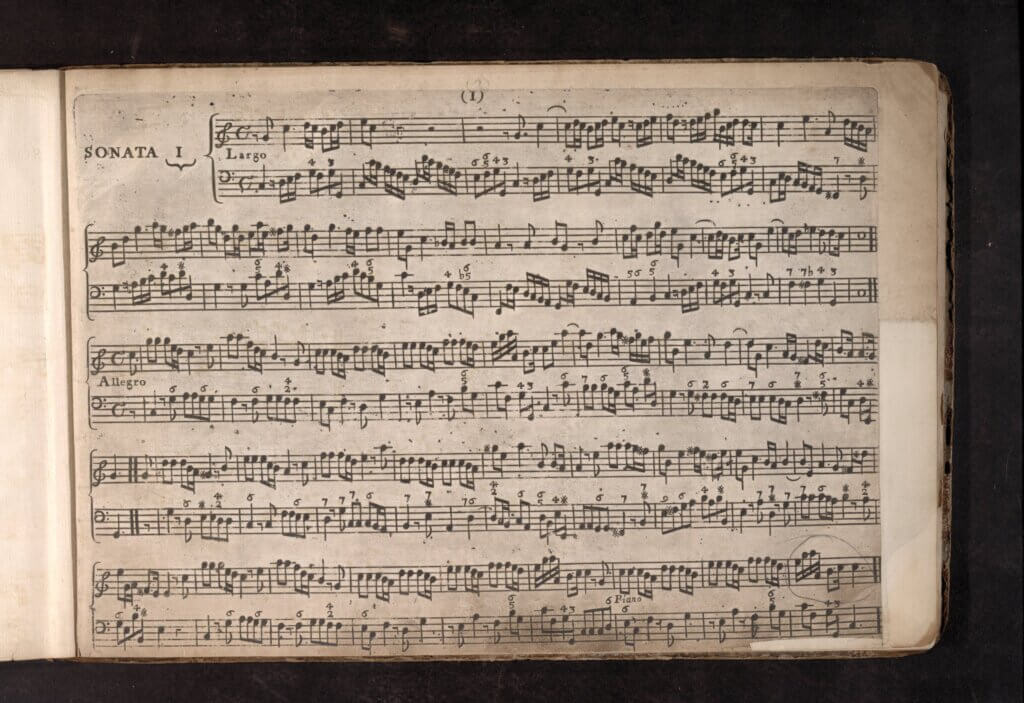
This 1705 volume of violin solos doesn’t appear in the ESTC because it’s entirely intaglio, not letter press—that is, it was printed on a rolling press with plates, and as such, doesn’t fall within traditional bibliographical inquiry. [Please note that although I said in the talk that this was in the ESTC because of a letterpress imprimatur, it in fact does not. There are other examples of that sort of book, however; just search “violin solo” in ESTC and you’ll see what I mean.]
John Christopher Pepusch, Solos for a violin with a thorough bass for the harpsichord or bass violin. London: J. Walsh, 1705.
University of Pennsylvania, Oblong M219 .P425 (public domain)

Even in works that include letterpress text with intaglio prints, the images fall by the wayside in cataloging and description. In this copy of Soldini’s De anima brutorum commentaria, the intaglio image on the left is of a collection of animals printed in blue; the initial letter on the right is printed in a lighter blue.
Francesco Maria Soldini, De anima brutorum commentaria. Florence: Gaetano Cambiagi, 1776. (sigs. a7v–a8r); Getty Research Institute, QL785 .S7255 1776 (public domain)
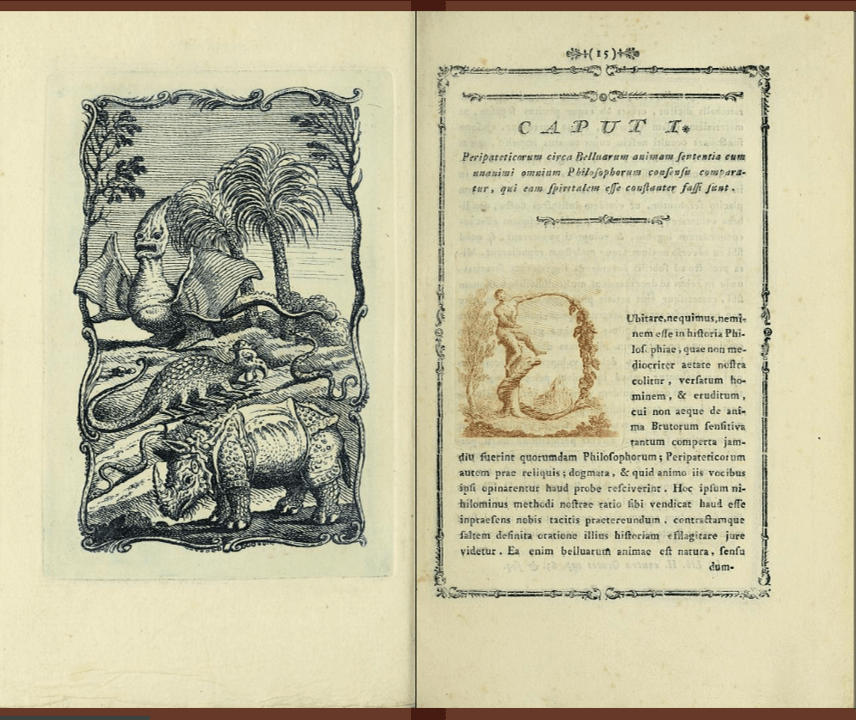
But in this copy of the same work, the image on the left is different and the initial letter is printed in sepia ink. If there were textual features that differed so distinctly from copy to copy, they would surely be recorded and carefully studied. Even though plates are printed separately from letterpress text, and therefore often separate from the book’s structure and attached to bound books in different orders, the use and distribution of plates could be a fruitful object of study.
Francesco Maria Soldini, De anima brutorum commentaria. Florence: Gaetano Cambiagi, 1776. (sigs. a7v–a8r); Smithsonian Libraries, QL785 .S7255 1776X (public domain)
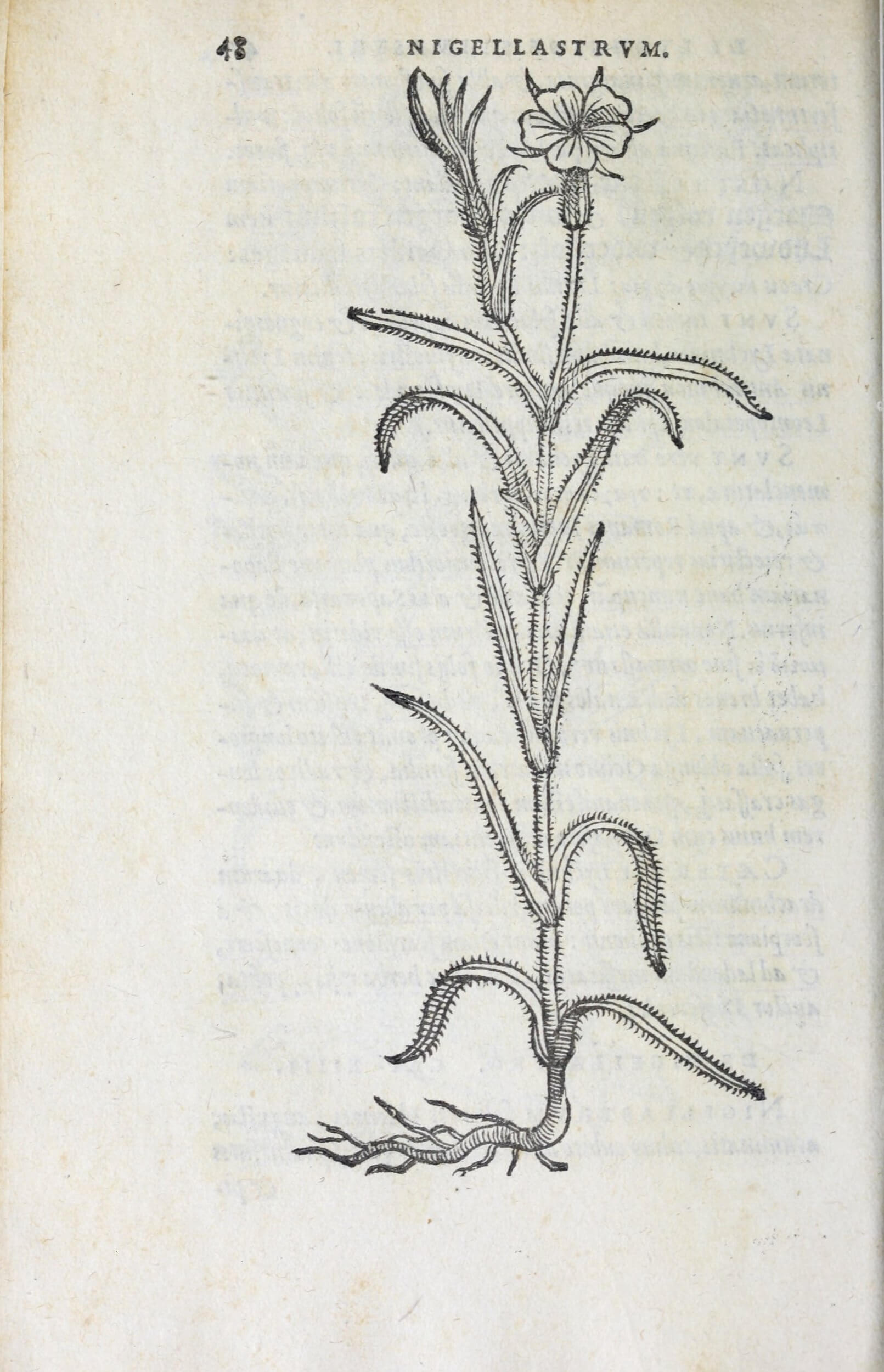
What about woodblocks printed simultaneously with the text on a common press? Here is a woodblock printing of a corn-cockle from a 1568 printing of Dodoens’s herbal, printed from a block that is still held by the Plantin Moretus Museum. Despite the fact that woodblock printing is done on the same common press as type, and despite the long history of block reuse, bibliographers have generally been uninterested in woodblocks aside from when they can help with printer identification.
Rembert Dodoens, Florvm, et coronariarvm odoratarvmqve nonnvllarvm herbarvm historia. Antwerp: Christopher Plantin, 1568. (sig. C8v); Getty Research Institute, QK41 .D64 (public domain)
Woodblock, Agrostemma githago [common corn-cockle], ca. 1568 (recto); Museum Plantin-Moretus, MPM.HB.04094 (public domain)

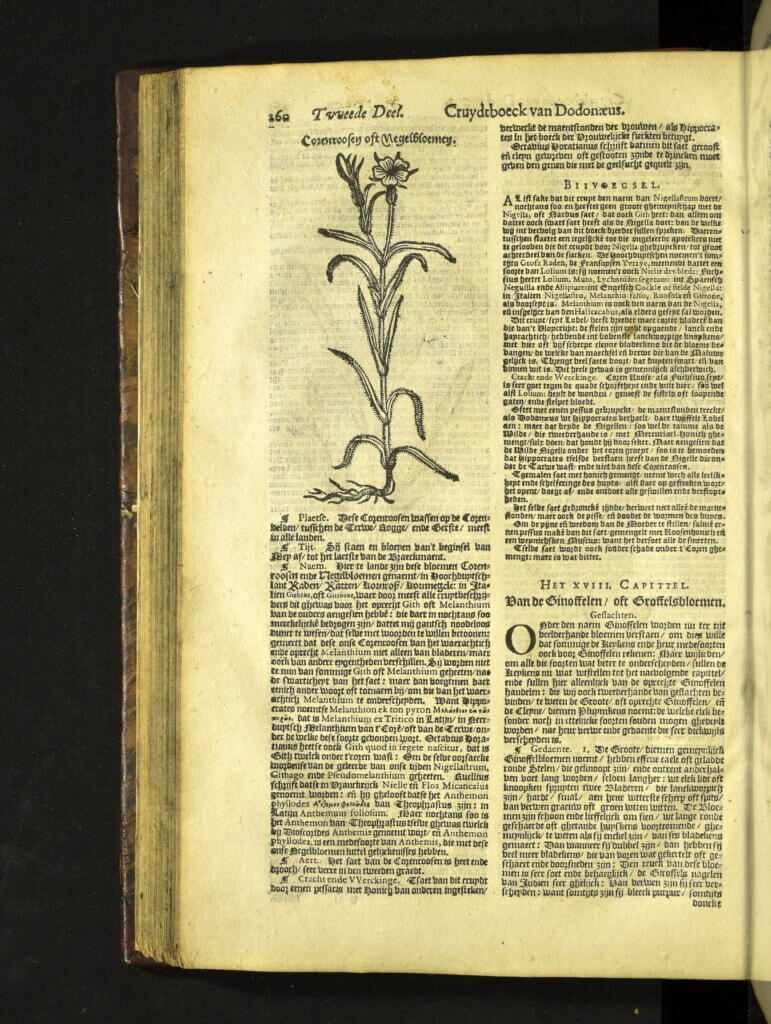
To the left, a 1618 Dodoens printed with the same block; below, a 1633 Gerard herbal.
Rembert Dodoens, Cruydt-boeck. Leiden: Franciscus Raphelengius for Christopher Plantin, 1618. (sig. Y4v); Erfgoedbibliotheek Hendrik Conscience, G 51476 [C2-516 a] (public domain)
John Gerard, The herball, or, Generall historie of plantes. London: Adam Islip, Joyce Norton, Richard Whitakers, 1633. (sig. 4Y2r); Getty Research Institute, QK41 .G3 1633 (public domain)
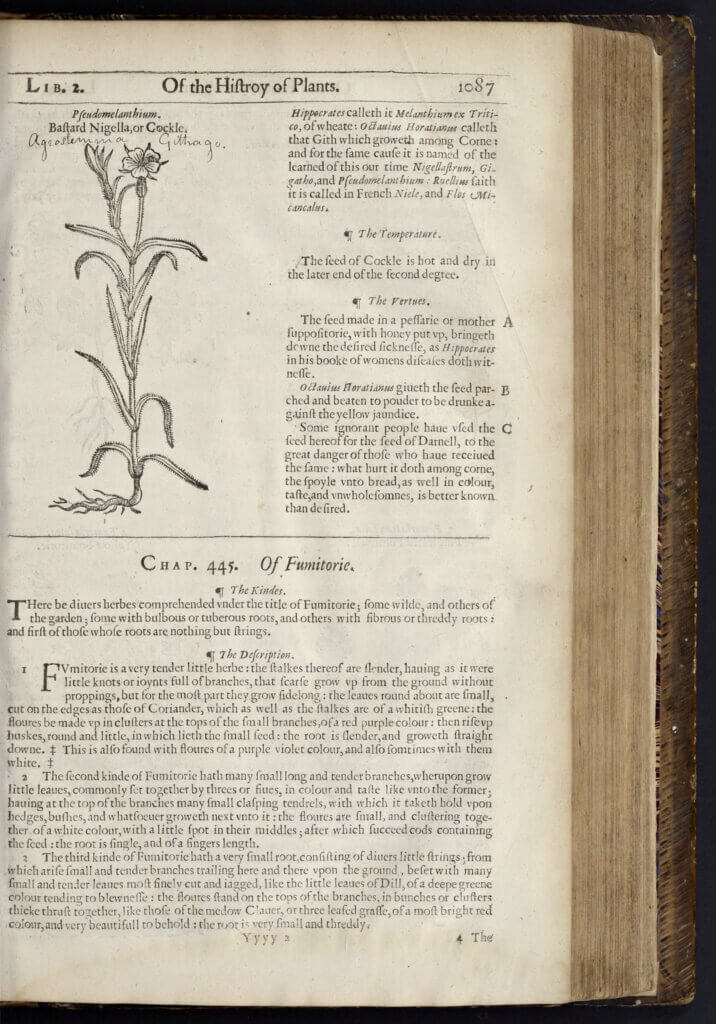
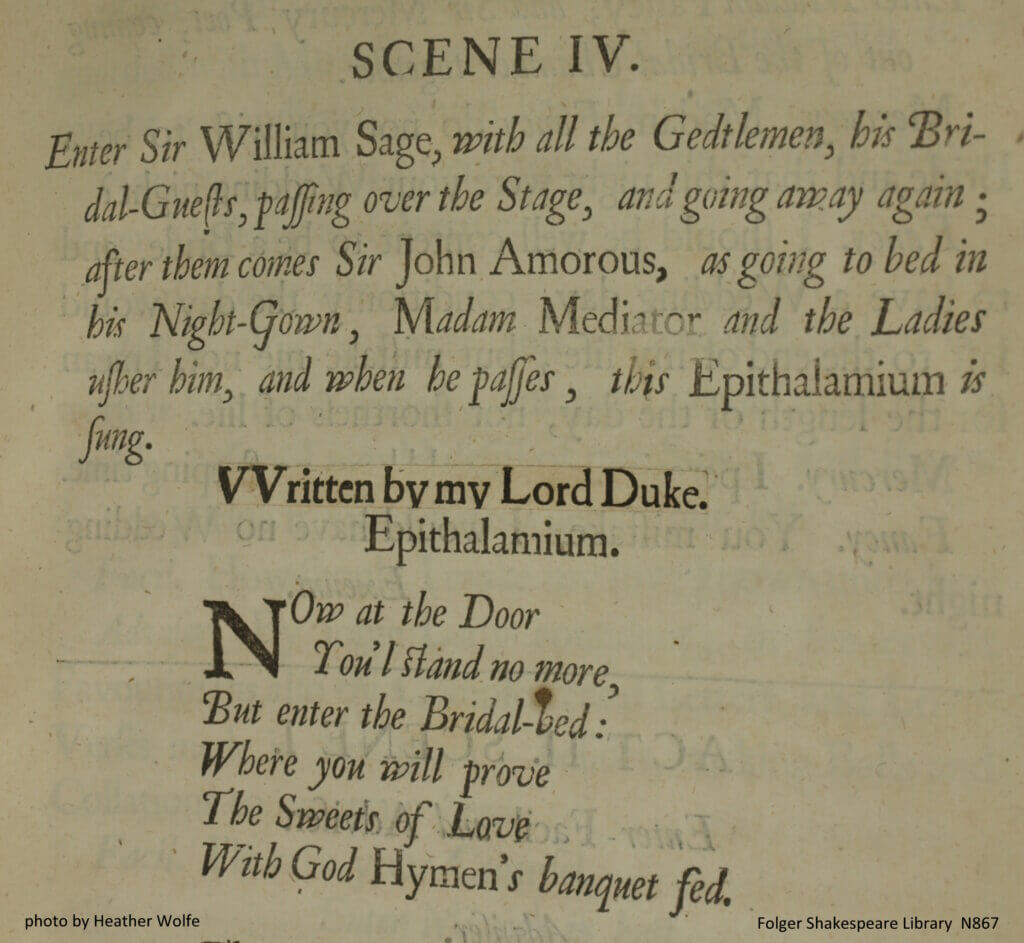
Margaret Cavendish frequently emended her printed works before distributing them. Here we see a pasted-in slip reading “Written by my Lord Duke.” on the left, and a hand-written correction of “civil” to “cruell” below. Because these interventions happen in between the end of printing and the start of distribution, they fall outside of traditional bibliographical inquiry, despite the rich opportunities they provide for studying the creation and circulation of Cavendish’s work.
Margaret Cavendish, Plays, never before printed. Written by the thrice noble, illustrious, and excellent princesse, the Duchess of Newcastle (London, [1668]); Folger Shakespeare Library N867; both photos taken by Heather Wolfe (CC BY-NC)

These bibliographical parameters that I’ve just outlined come from the field’s interest in answering questions that were often driven by a fascination with Shakespeare and establishing which of the printed versions of his plays were the closest to what he intended; hence the focus on text not image and on the workings of letterpress print shops.
There are very good reasons why descriptive bibliography forms the basis of so much bibliographical and textual study and why it studies the selection of objects it does. You can’t compile lists of texts to study if you don’t know what you’re putting on that list (Is it a work’s first printing? Second printing? Maybe it should be the second edition?). You can’t understand how the copy you’re looking at relates to other copies of that book until you understand where it fits into that work’s genealogy. And you can’t edit (or analyze) a text if you aren’t sure whose words are on the page, the writer’s, the compositor’s, the result of pied type. Without this level of close observation that descriptive bibliography supplies, we wouldn’t have answers to many of the questions that bibliographers have wondered about, like were Shakespeare’s plays pirated and how can we get back to Shakespeare’s words without this darn veil of print?
I’m kind of laughing but I’m also serious in pointing out that this focus on Shakespeare has shaped much of how bibliography was developed and in wondering whether that serves us well. At the same time, I want to make sure we remember that much of what we know about the practices of early modern printing come from the long hard work of past bibliographers. We are all standing on their shoulders, and their work forms the basis of much of what we know about the history of western printing and the book trade.
So how did our founding bibliographers answer these questions about past printing practices? In part by looking at lots and lots of books. One of the most important principles of descriptive bibliography is that you want to look at as many copies of an edition as possible so that you can have a full picture of what the variations between them might be and then you can figure out what those variations might be telling us. And that makes sense—if you only look at 3 of 5 extant copies, you might miss the cancel that appears in copy 4 and the variant imprint on copy 5. (It’s also a mammoth logistical problem, then and now; more on that in a moment.)
Looking at lots of books is not only part of describing an edition. It also has been how we’ve come to understand what early printed books are. Early bibliographers examined books, came to conclusions about how they were made, and then used those conclusions to interpret and assess other books, and then people like Philip Gaskell and me use those conclusions to write books to train people to study books. I find it easiest to think about this process along these lines: look at specific instances of books to create general principles that you can apply to other books. It’s one of the things that makes bibliography a useful tool: you don’t need to examine all instances of printed texts in order to understand the general workings of printed texts. And it’s a pretty standard way of thinking about the scientific method: Look at some number of things, derive a principle of how they work from that observation, and then use that principle to understand the things you haven’t looked at yet.
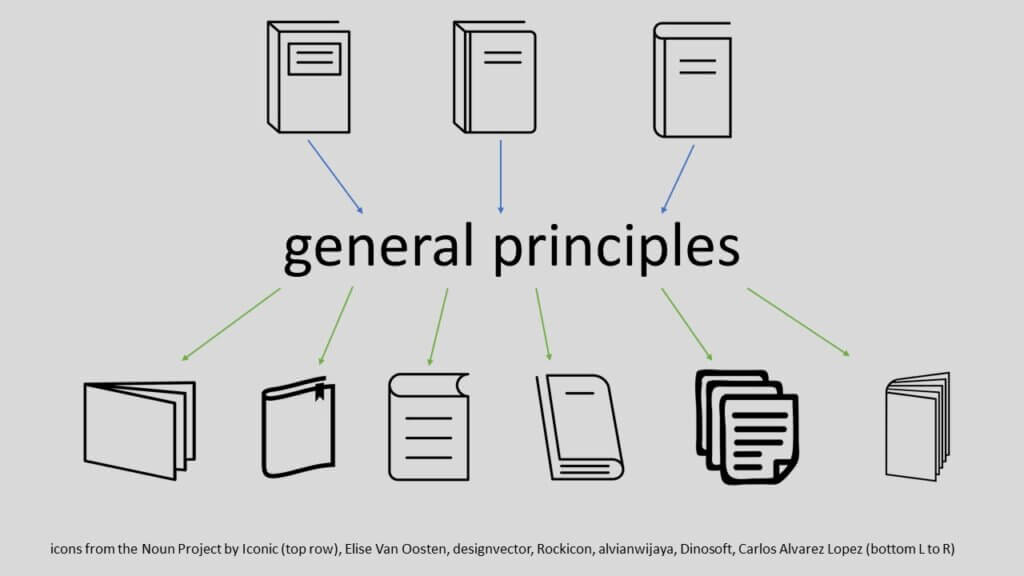
But there are also some tricky bits to this process. For starters, it’s no accident that I chose icons that look similar for that top row, but that the items all on the bottom, the ones that are being analyzed by the principles derived from the books at the top—those icons all look different, from each other and from the books at the top. One of the dangers of working from a small set to derive practices and theories for working with a larger set is that the smaller set often does not represent the full variety of the larger. Here we have bibliographers focused primarily on English early modern playbooks working with those and related texts from the period up at the top. And here we are at the bottom, using those principles to understand all sorts of textual objects, including broadsides, almanacs, jobbing work, books with moving parts, books that are composed of plates, hybrid books that are both manuscript and print, books that have been altered by their creators in that moment between production and circulation—and maybe even newspapers, stereotypes, offset flyers, and e-books.
Put another way, descriptive bibliography depends on books being repeatable objects, things that exist in enough copies that that variations are noticeable. But what if textual objects aren’t repeatable? It also focuses entirely the acts of production. But what if the importance of some objects is in how they are modified in the hands of users?
In other words, are the concerns that drove those early principles useful to us today? The texts that formed the basis of descriptive bibliography are primarily canonical, male-authored, bound codices. What are the biases of those texts that might shaping how we understand, say, Melesina Trench or Phillis Wheatley Peters? What should we do with texts that only ever circulated in manuscript? Texts printed on woodblocks over a period of years and years? Texts that are not ink on surface, but knots in thread? Sure, we can say that those aren’t the concern of bibliography, but what does it do to our field that the basic terms of our analysis don’t speak with the basic terms of analysis of other textual studies? And when those other categories of text are categories where we find a lot of work by people other than white men living in the west?
My point isn’t that bibliography cannot or should not address these other categories and concerns. My point is that it was not built to do that, and that maybe instead of devoting energies to expanding the terms of descriptive bibliography, we should ask ourselves if there are other methods suited to our work. Do we want to wrest the work of anonymous authors circulating in manuscript into this framework? Do we really want to make Chinese woodblock books squeeze themselves into fitting into these principles? Are we just going keep ignoring textual artifacts that don’t belong to the categories of texts that we were studying 150 years ago?
Let’s return to my earlier comment that the aims of bibliography have been the aims of professional men of learning and what this means for those of us who are not in that category.
Anglo-American bibliography has of course included women among its practitioners since its earliest years and some of the resources we rely on today were created by women and scholars working on different categories of texts. Henrietta Bartlett, Dorothy Porter, Katharine Pantzer—these are some of the biggest twentieth-century names in the field. And there is increasing research being done on their work and histories, as well as those of other women involved in bibliography and the book trades. I have no doubt—and you shouldn’t either—that women were involved in the making and circulation and study of textual artifacts since they first began to be made and circulated and studied. So my point is not that women have not done and cannot do any of this work.
But bibliography as we have been practicing it requires a huge amount of time and money and travel in order to do it. The premise that you must look at as many copies as possible and that you must look at them in person means, for instance, that anyone with any sort of caretaking responsibilities has a hard time doing that work. If you have young children, or teens, or a partner, or elderly parents, or anyone who needs you to help feed or drive or generally make sure they stay healthy and alive—if that’s your life, you can’t do this work easily, or sometimes not even with difficulty.3I did not address this in my talk, and I am sorry I did not, because it is part-and-parcel of everything else I said: In addition to needing time and money and the ability to travel, you also need to have the physical ability to travel. Disabled people are overwhelmingly excluded from academic habits of work and being. Traveling to conferences to meet colleagues and share your work might involve risking damage to expensive adaptative tools (the damage that wheelchairs are routinely subject can be economically and emotionally hazardous), bringing along a companion or assistant, not to mention the extra layers of time and energy to try to understand in advance what will be an obstacle and who will be a helpful resource. All of that holds true for travel for research—seen as a necessary component of good scholarship—whether that would involve flights and trains across continents or navigating the single mile and fancy architecture between you and the library down the street. And women are overwhelmingly the ones who are primary caretakers.
Let’s talk about the ways in which basic bibliographical work does not tend to be rewarded in academia—at many places, doing an edition will not count for a thesis, compiling a descriptive bibliography will not count for promotion and tenure, even publishing a bibliography of understudied works—something that future researchers can build off of and create new studies from—those bibliographies have a miserable time finding publication venues. How do you do this work if it doesn’t get you a degree or a job or the funds to do the necessary research?
And should we talk about the state of academia and research in general? Jobs that offer stability and a living wage are few and far between. You can function as an independent scholar, but if you want to get money from a funding agency for it, you almost always have to give up all your other paid work while you’re on the grant. That’s a system that can work great for standing faculty, who have a salary and benefits and a multi-year contract. But for the rest of us, completely giving up the hustle that makes up your income—whether it’s freelance work or a day job doing graphic design—isn’t really an option. For those of us in the United States, where access to health care is often predicated on having a job that provides medical insurance, anything that disrupts your benefits can have lifelong consequences. And again, women are overwhelmingly the ones who are working in precarious jobs, which makes access to research funds absolutely a feminist issue.
Oh, and let’s note that rare books spaces are often designed in ways that model gentlemen’s libraries,4For more on the impact of how rare books spaces reflect the tradition of gentlemen’s libraries, see Jesse Ryan Erickson, “The Gentleman’s Ghost: Patriarchal Eurocentric Legacies in Special Collections Design,” in Archives and Special Collections As Sites of Constentation, ed. Mary Kandiuk (Sacramento, CA: Library Juice, 2020), 121–158. that are guarded by people who are too often the only people of color in the library, and that have security practices that require monitoring people’s appearances and behavior. Now imagine you are someone who is a first-generation student, or who is Black, or who is genderqueer. Imagine your comfort levels in constantly entering these spaces and being stared at.
I’ll wrap up on two final notes:
The first is that it is important—necessary, even—to have more people doing this research from a broader range of perspectives. Part of this is because different experiences allow people to see different things in our collections. Jenn Shapland’s memoir My Autobiography of Carson McCullers (Tin House Books, 2020) is an incredible account of her research into Carson McCullers and her reflections on her own queer life is a powerful example of what this means: Without Shapland’s own experience of being queer and closeted, she would not have recognized the signs in McCullers’s writings and archives that led her to see McCullers as queer and to find the love letters she and her partner sent.5During this entire section—from after listing the varieties of texts bibliography could be considering (at the 34:03 minute mark), until the start of this sentence (at 40:29)—the slide of the abortion flyer had been on screen. It would be safe to assume that the six-minute image was deliberate. And without seeing McCullers in the archives, she makes clear in her memoir, Shapland would not have been able to understand herself, to reshape her own life, to create the creative and scholarly and fulfilling life she’s living now.
Especially now, we need to point to our past and show its full variety—that women, and queers, and trans people, and people of color—-we have always existed, we’ve always been part of life and part of books and part of history. And when we find that words from the seventeenth-century are being selectively read to defend some sort of fake ”originalist” sense of what they would have meant in that time period, we have obligations to do a better job of expanding that past to show it in its full variety that is there, to do a better job of bringing the public into that work and bringing that work out into the public.6I want to be clearer here than I was when I was speaking: I absolutely mean that we need to bring the public into our work on the past, not that we need to bring the public into the past. History and the past are not static things we discover and share, but frameworks we construct. Those of us who have been trained to study these fields sometimes think we own the correct understanding of the past, but it doesn’t work like that, or it shouldn’t—-the past is a construct and professionals have as much to learn from the public in that construction as vice versa.
And finally, I want to come back to counting and to categorizing. We categorize things as bibliographers as a basic function of our work. But categorizations are not neutral, and they are not locked into place. Just because we used to see books as existing in one way doesn’t mean that they have always existed in that way. Just because we are insistent that these definitions meant something in the nineteenth century doesn’t mean that they have to mean that same thing today. Just because white property-owning men controlled most of the official records of and decisions around books and laws in the past doesn’t mean that those are the values we need to replicate today. We cannot do the work that we need to do for the future of bibliography if we cannot expand how we support that work and who is included in that work. Thank you.
notes
- 1W. W. Greg, “Bibliography—A Retrospect,” in The Bibliographical Society 1892–1942: Studies in Retrospect (London: BIbliographical Society, 1945), 24.
- 2G. Thomas Tanselle, “Bibliography Defined” (2020) https://bibsocamer.org/about-us/bibliography-defined/.
- 3I did not address this in my talk, and I am sorry I did not, because it is part-and-parcel of everything else I said: In addition to needing time and money and the ability to travel, you also need to have the physical ability to travel. Disabled people are overwhelmingly excluded from academic habits of work and being. Traveling to conferences to meet colleagues and share your work might involve risking damage to expensive adaptative tools (the damage that wheelchairs are routinely subject can be economically and emotionally hazardous), bringing along a companion or assistant, not to mention the extra layers of time and energy to try to understand in advance what will be an obstacle and who will be a helpful resource. All of that holds true for travel for research—seen as a necessary component of good scholarship—whether that would involve flights and trains across continents or navigating the single mile and fancy architecture between you and the library down the street.
- 4For more on the impact of how rare books spaces reflect the tradition of gentlemen’s libraries, see Jesse Ryan Erickson, “The Gentleman’s Ghost: Patriarchal Eurocentric Legacies in Special Collections Design,” in Archives and Special Collections As Sites of Constentation, ed. Mary Kandiuk (Sacramento, CA: Library Juice, 2020), 121–158.
- 5During this entire section—from after listing the varieties of texts bibliography could be considering (at the 34:03 minute mark), until the start of this sentence (at 40:29)—the slide of the abortion flyer had been on screen. It would be safe to assume that the six-minute image was deliberate.
- 6I want to be clearer here than I was when I was speaking: I absolutely mean that we need to bring the public into our work on the past, not that we need to bring the public into the past. History and the past are not static things we discover and share, but frameworks we construct. Those of us who have been trained to study these fields sometimes think we own the correct understanding of the past, but it doesn’t work like that, or it shouldn’t—-the past is a construct and professionals have as much to learn from the public in that construction as vice versa.

